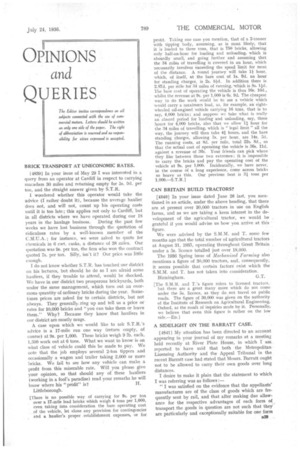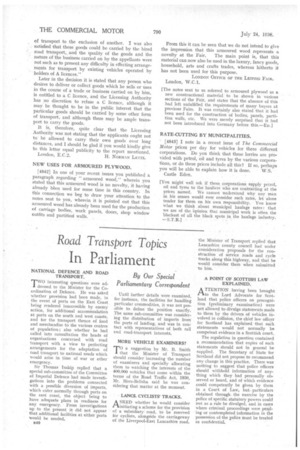OPINIoNs
Page 53

Page 54

If you've noticed an error in this article please click here to report it so we can fix it.
and
QUERIES
The Editor invites correspondence on ail subjects connected with the use of commercial motors. Letters should he written on only one side of the paper. The right of abbreviation is reserved and no responsibility for views expressed is accepted.
BRICK TRANSPORT AT UNECONOMIC RATES.
[4839] In your issue of May 29 I was interested in a query from an operator at Cardiff in respect to carrying macadam 30 miles and returning empty for 5s. 9d. per ton, and the straight answer given by S.T.R.
I wondered whether this operator would take the advice (I rather doubt it), because the average haulier does not, and will not, count up his operating costs until it is too late ; this applies not only to Cardiff, but in all districts where we have operated during our 18 years in the haulage business. During the past few weeks we have lost business through the quotation of ridiculous rates by a well-known member of the C.M.U.A. ; for instance, we were asked to quote for chemicals in 6 cwt. casks, a distance of 38 miles. Our quotation was 9s. per ton, the firm who won the contract quoted 7s. per ton. Silly, isn't it? Our price was little enough.
I do not know whether S.T.R. has touched our district on his lectures, but should he do so I am afraid some hauliers, if they trouble to attend, would be shocked. We have in our district two prosperous brickyards, both under the same management, which turn out an enormous quantity of ordinary bricks during the year. Sometimes prices are asked for to certain districts, but not always. They generally, ring up and tell us a price or rates for 10,000 bricks and "you can take them or leave them." Why? Because they know that hauliers in our district are mostly mugs.
A case upon which we would like to ask S.T.R.'s advice is a 17-mile run one way (return empty, of course) at 9s. per 1,000. These bricks weigh 9 lb. each, 1,500 work out at 6 tons. What we want to know is on what class of vehicle could this be made to pay. We note that the job employs several 2-ton tippers and occasionally a wagon and trailer taking 2,000 or more bricks. We fail to see how any vehicle can make a profit from this miserable rate. Will you please give your opinion, so that should any of these hauliers (working in a fool's paradise) read your remarks he will know where his "profit" is? H. Littleborough.
[There is no possible way of carrying for 9s. per ton over a 17-mile lead bricks which weigh 4 tons per 1,000, even taking into consideration the bare operating cost • of the vehicle, let alone any provision for contingencies and a haulier's proper establishment expenses, or for proht. Taking one case you mention, that of a 2-tonner with tipping body, assuming, as is most likely, that it is loaded to three tons, that is 750 bricks, allowing only half-an-hour for loading and unloading, which is absurdly small, and going further and assuming that the 34 miles of travelling is covered in an hour, which necessarily involves exceeding the speed limit for most of the distance. A round journey will take 11 hour, which, of itself, at the bare cost of is. 9d. an hour for standing charges, is 2s. 8-id. In addition there is 2.87d. per mile for 34 miles of running, -which is 8.s. lid. The bare cost of operating the vehicle is thus 10S. 10d., whilst the revenue at 9s. per 1,000 is 6s. 9d. The cheapest way to do the work would be to use a vehicle which • would carry a maximum load, as, for example, an eightwheeled oil-engined -vehicle carrying 16 tons, that is to say, 4,000_ bricks; and suppose we take what is really an absurd period for loading and unloading, say, three hours for 4,000 bricks, also that we allow 11 hour for the 34 miles of travelling, which is " legal limit " all the way, the journey will then take 41 hours, and the bare standing charges, allowing 3s. per hour, are 14s. 3d. The running costs, at 8d. per mile, total 22s. Scl., so that the actual cost of operating the vehicle is 36s lid. against a revenue of 36s. Your friends can pick where they like between those two extremes ; it is impossible to carry the bricks and pay the operating cost of the vehicle at 9s. per 1,000. Incidentally, we have never, in the course of a long experience, come across bricks so heavy as this. Our previous best is 31 tons per 1,000.—S.T.R.]
CAN BRITAIN BUILD TRACTORS?
[48401 In your issue dated June 26 last, you mentioned in an article, under the above heading, that there are at present over 30,000 tractors in use on English farms, and as we are taking a keen interest in the development of the agricultural tractor, we would be , grateful if you would advise us how you arrive at this figure.
We were advised by the S.M.M. and T. some few months ago that the total number of agricultural tractors at August 31, 1935, operating throughout Great Britain under a 5s. licence totalled just over 18,000.
The 1936 Spring issue of Mechanized Farming also mentions a figure of 30,000 tractors, and, consequently, it seems possible that certain factors' exist which the S.M.M. and T. has not taken into consideration.
Birmingham. G,T.
[The S.M.M. and T. 's figure refers to licensed tractors. but there are a great many more which do not come under the 5s. licence, as they do not travel on public roads. The figure of 30,000 was given on the authority of the Institute of Research on Agricultural Engineering, Oxford, as the result of inquiries made by it. Personally, we believe that even this figure is rather on the low side.—ED.]
A SIDELIGHT ON THE BARRATT CASE.
14841] My attention has been directed to an account appearing in your journal of my remarks at a meeting held recently at River Plate House, in which I am. reported to have said that both the Metropolitan Licensing Authority and the Appeal Tribunal in the recent Barratt case had stated that Messrs. Barratt ought not to be allowed to carry their own goods over long distances.
desire to make it plain that the statement to which I was referring was as follows:— "I was satisfied on the evidence that the appellants' manufactures are of the class of goods which are frequently sent by rail, and that after making due allowance for the respective advantages of each form of ,. transport the goods in question are not such that they are particularly and exceptionally suitable for one form
of transport to the exclusion of another. I was also satisfied that these goods could be carried by the hired road transport,. and the quality of the goods and the nature of the business carried on by the appellants were not such as to present any difficulty in effecting arrangements for transport by existing vehicles operated by holders of A licences."
Later in the decision it is stated that any person who desires to deliver or collect goods which he sells or uses in the course of a trade or business carried on by him, is entitled to a C licence, and the Licensing Authority has no discretion to refuse a C licence, although it may be thought to be in the public interest that the particular goods should be carried by some other form of transport, and although there may be ample transport to carry the goods.
It is, therefore, quite clear that the Licensing Authority was not stating that the applicants ought not to be allowed to carry their own goods over long distances, and I should be glad if you would kindly give to this letter equal publicity to the report mentioned.
London, E.C.2. H. NORMAN LETTS.
NEW USES FOR ARMOURED PLYWOOD.
[4842] In one of your recent issues you published a paragraph regarding "armoured wood," wherein you stated that this armoured wood is no novelty, it having already ben used for some time in this country. In this connection we beg to draw your attention to the notes sent to. you, wherein it is pointed out that this armoured wood has already been used for the production of carriage bodies, work panels, doors, shop window outfits and partitiori walls. From this it can be seen that we do not intend to give the impression that this armoured wood represents a novelty at the Fair. The main point is, that this material can now also be used in the luxury, fancy goods, household, arts and crafts trades, whereas hitherto it has not been used for this purpose.
LONDON OFFICE OF TEE LEIPZIG FAIR. London, W.C.1.
[The notes sent to us referred to armoured plywood as a new constructional material to be shown in various sections of the Fair, and states that the absence of this had left unfulfilled the requirements of many buyers at previous Fairs. It was certainly also stated that it had been used for the construction of bodies, panels, partition walls, etc. We were merely surprised that it had not been introduced into Germany before this.—En.]
RATE-CUTTING BY MUNICIPALITIES.
[4843] I note in a recent issue of The Commercial Motor prices per day for vehicles for three different corporations. Do you think that these lorries are provided with petrol, oil and tyres by the various corporations, or do these prices include all this? If so, perhaps you will be able to explain how it is done. W.S. Castle Eden.
[You might well ask if those corporations supply petrol, oil and tyres to the hauliers who are contracting at the prices named. We cannot understand why any man in his senses would ever consider such rates, let alone tender for them on his own responsibility. You know what we think about municipal haulage rates : that we are of the Opinion that municipal work is often the blackest of all the black spots in the haulage industry. --S.T.R.]




























































































